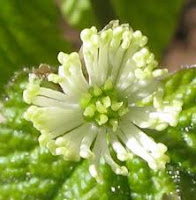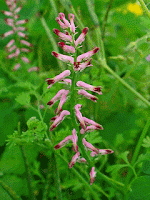 DOG ROSE, ROSA CANINA
DOG ROSE, ROSA CANINA The dog rose can be found in hedgerows in Britain, mainland Europe, North Africa and south western Asia. It has been used in traditional medicine for centuries and as a beauty aid. Cleopatra is said to have soaked the sails of her barge with rose water to impress both Julius Caesar and Mark Anthony.
It is thought that this wild rose originated in the East and spread to
Persia (now
Iran) and
Babylon, then was taken by Arab traders to
Egypt, from where it was transported to ancient
Greece and
Rome, where it flourished along with the wild damask rose. Roses were worn as garlands around the necks of ancient Romans and figured in feasts, orgies and marriages. The
rose, particularly the red rose, has been a symbol of love for centuries. Wild roses are closely related with the cultivated ones and belong in the same Rosaceae family as
plums,
loquats,
apricots,
almonds and a multitude of other plants which provide us with fruit and nuts.

The wild rose or dog rose gets its name from the Old word “dag” for dagger which refers to its thorns and the tale of the Devil who was tormented by the thorns when he fell from grace into a wild rose bush. Some believe that the word ‘dog’ came about as Pliny says that the Romans used the roots of the wild rose to cure the bites of rabid dogs.
Nicholas Culpeper writing his herbal in the 17th century has this to say of the dog rose: -
“Government and virtues. It is under the dominion of the moon. The flowers of the wild-briar are accounted more restringent than the garden-roses, and by some are reckoned as a specific for the excess of the catamenia. The pulp of the hips has a pleasant grateful acidity, strengthens the stomach, cools the heat of fevers, is pectoral, good for coughs and spitting of blood, and the scurvy. The seed has been known to do great things against the stone and gravel; and the same virtues are attributed to the spongy excresence which grows upon the stalk. The best way of preserving its virtues is, by keeping it conserved.”

The German Commission E might agree with Culpeper’s last statement, as they have stated that the fruit loses a lot of its natural potency as regards health benefits soon after it is picked. This means that you should use freshly picked fruit – hips or dried powder. By “restringent,” Culpeper means astringent I believe and this is affirmed by modern science. The dog rose petals have more astringency as do the leaves than those of other roses. This means that they can be used to treat stomach upsets and can be applied to wounds. Usually this is done in the form of a wash.
A tisane, syrup and rose water can be made with the parts of the dog rose, and rose petal jam is a good preserve. The fruit or hips can be eaten raw or cooked and this begins to appear in October but is sweeter and softer after a frost. The flowers are in bloom in June and July and decorate the hedges with their pink or pink and white, or more rarely white flowers. I used to be fascinated with these wild roses and was told that they were brought to Britain by the Romans. However this is made reference to so far as I have found on the Net. I liked to believe it was true, and of course, it may be. It can grow to 3 metres (9 feet) tall by the same dimensions wide.

The dried leaves of the dog rose can be powdered and made into a tisane, which is said to help with stomach upsets. The petals can be made into rose water, but it takes a long time. You can pick the flowers on a sunny day when they are at their most fragrant and put them into an enamel pan or a stainless steel one, and cover them with fresh spring water or distilled water. Cover the pan and put it on a low heat and bring it to a simmer. Turn the heat down as low as you can and heat it through for 10 minutes, lightly covered. Turn off the heat and allow the flowers to steep overnight, then, in the morning, strain the liquid and add a quarter of the volume of alcohol to preserve it. Bottle it in sterile glass jars or bottles and store in a cool dark place. This is a useful toner for the skin and can be used as a wash for acne and other skin blemishes. You can also use it in cooking and it is very good in milky puddings, such as rice pudding, or with fruit salads.
Rose hip tisane has mild laxative properties, probably because of the malic and citric acids it contains along with pectin. You can make a jelly with rose hips as you can with
crab apples.

Rose hip oil is a good moisturizer and rejuvenates the skin. This is obtained from the seeds contained in the hips. These are rich in vitamin E and they can be ground and mixed with flour or added as a thickener to sweet dishes. However they are fiddly to deal with as you should really remove the tiny hairs that grow on the seeds. Boiled seeds have been used to treat the pains of rheumatism, arthritis and gout and should be boiled for at least an hour if you are thinking of using the remedy.
In Anatolia the fruit is used in the treatment of diabetes, and a study by Orhan N. et al., published in 2009 in the Pharmacognosy Magazine Vol. 5 (20) pp 309-15 “Anti-diabetic Effect and Antioxidant Potential of Rosa Canina Fruits” supported this traditional use. Other Turkish research has shown the anti-inflammatory effects of extracts of the fruit.
Rose hips from the dog rose contain fatty acids, which is unusual for a fruit, and they have more vitamin C than
oranges or any other citrus fruit (so was useful during the Second World War in Britain) as well as
vitamins A, D, E and K, and the
minerals, boron, sodium, calcium, copper, zinc, iron, potassium, magnesium, manganese and phosphorous. There are also bioflavonoids, tannin, carotenoids including β-carotene and some of the
B-complex vitamins. As it is red, as are
strawberries,
tomatoes and
watermelons, it contains lycopene, which reduces the risk of prostate cancer in men.
A Danish study conducted by R. Christenson published in 2008 has suggested that the extracts of the rose hips of this particular wild rose may indeed soothe the pain of inflamed joints, and osteoarthritis.
The following recipe is to be used with freshly picked rosehips and is a syrup which can be given to people suffering from colds, flu etc as it will boost the immune system and reduce the number of days the symptoms stay. It can also be used in winter as can the infusion of the hips to boost the immune system and so lessen the risk of colds and so on. However, it takes ages to make, although you don’t have to look after it while it simmers.
ROSE HIP SYRUP
 Ingredients
Ingredients 2 pints water
4 ozs fresh rose hips
1lb sugar
Method
Put the hips and water in a pan and cover it. Bring the water to the boil and boil, covered for 20 to 30 minutes.
Strain the liquid and clean the pan, then pour the liquid back into it.
Leave it uncovered on a very low heat until only 7 fluid ounces are left. (This is what takes the time.)
Add the sugar and still on a very low heat, simmer until it dissolves.
Allow it to cool a little before bottling it.
Store in a cool dark place.
 In the traditional Chinese medicine system it has been used for malaria and heart failure, but tests have not substantiated this use.
In the traditional Chinese medicine system it has been used for malaria and heart failure, but tests have not substantiated this use. When its popularity grew in the late 1990s the little plant became at risk of being endangered and is on the list of the Convention on International trade in Endangered Species of Flora and Fauna (CITES) as an endangered species due to its over-harvesting.
When its popularity grew in the late 1990s the little plant became at risk of being endangered and is on the list of the Convention on International trade in Endangered Species of Flora and Fauna (CITES) as an endangered species due to its over-harvesting. The Native Americans primarily used it for skin problems and it has a reputation for being good as a skin wash being credited with stopping pitting after chicken pox and smallpox. They also used the yellow juice from the root as a dye for clothes, body paint and to colour weapons.
The Native Americans primarily used it for skin problems and it has a reputation for being good as a skin wash being credited with stopping pitting after chicken pox and smallpox. They also used the yellow juice from the root as a dye for clothes, body paint and to colour weapons.



















































